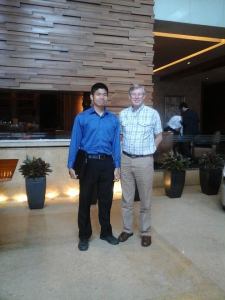“There is no right or wrong, yes or no in the event industry”
Interviewed by Ly Nguyen Ha Giang – s3411910 – Group 1 – SGS
Yes, I really want to meet this lady! I have to and I will!
I kept logging into Ms. Vu Thi Hoai Thuong’s profile – the account manager at Square Event – every day after accidentally finding her on LinkedIn. This lady with a smiling face creates the feelings that she is easy to talk to. This lady has the valuable experience with nearly five years working in the account team of different agencies such as 2res Co., Golden Communication Group and Square Group. She has the skills. She is exactly the one I had been looking for to write a magazine article about.
Square Event established in 2005 is a part of Square Direction Communication Group providing three core services to their clients including special event, activation and show management. Specifically, Ms. Thuong shared that in Square, account managers are not only responsible for handling the clients, being the representative of clients in the agency and the bridge to deliver the messages from agency to the clients, they are also in charge of the whole projects from A to Z as the project leaders.
Being the project leader is one of the advantages supporting Ms. Thuong as an account manager as she will have an overview and know the project inside out; thus, when clients approaching her for feedback, comments, etc. with aggressive attitude, she knows how to cool them down.
“Clients are our God. It’s true. But not always. Sometimes they’re right and sometimes they’re wrong” – she pointed out – “But of course clients always know their brands more than we do”. Therefore, she shared that when her clients comment or feedback on their ideas, the first thing she would do is to listen to her clients. “Never say yes or no immediately” – she emphasized – “Simply say that I’ll take your feedback and comments to my team, then we’ll consider whether these ideas are suitable with your brands or the event or not”. If they are right, we will follow them. If they are not, do not say they are wrong, but explain that those comments are not suitable with the values of the events and your brands; therefore, we should follow A B C solutions.
“Actually, I think ‘clients are our God’ depends a lot on the account managers. Even though their feedback is wrong, we still have to show that they are our God and we respect them in every decision. Don’t tell them you are right or wrong. There’s no right or wrong, yes or no in this industry. There are only suitable or not suitable” – She kept repeating this point of view.
What if clients still aggressively thought they are right?
“I’ll tell them that if you think this idea is the best, we’ll follow you, but we’re not sure about the results, and if they are not as we desire to achieve, you can’t blame Square on that. Square always passionately attempt to produce the best events for the clients, give them the most WOW ideas, but still respect every decision of their clients. Moreover, I’ll give them the big picture of how their decision will lead to, so that they can have a clearer expectation of the results”.
Solomon (2008, p.105) also agreed that “There is No No in your client vocabulary” and “when an unqualified yes isn’t possible, offer a qualified one: “Here’s what we can do; it’s not a perfect solution, but does it address your need?”. Furthermore, Solomon (2008, p.105) suggested that the agencies should discuss, negotiate, collaborate, solve the problem together with their clients; clients will eventually accept the agencies’ solutions, especially when they have seen your effort. That is the working motto of Ms. Thuong, which has been helping her build and maintain good relationships with the clients.
Word count: 625 words (not include Title and Captions).
References
Solomon, R 2008, The Art of Client Service, Kaplan Publishing, New York, NY.
































